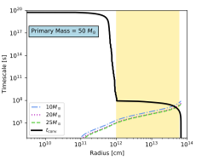
Abstract
The formation pathways for gravitational-wave merger sources are predicted to include common envelope (CE) evolution. Observations of high-mass post-common envelope binaries suggest that energy transfer to the envelope during the CE phase must be highly efficient. In contrast, observations of low-mass post-CE binaries indicate energy transfer during the CE phase must be highly inefficient. Convection, a process present in low-mass and high-mass stars, naturally explains this dichotomy. Using observations of Wolf-Rayet binaries, we study the effects of convection and radiative losses on the predicted final separations of high-mass common envelopes. Despite robust convection in massive stars, the effect is minimal as the orbit decays well before convection can transport the liberated orbital energy to the surface. In low-mass systems, convective transport occurs faster then the orbit decays, allowing the system to radiatively cool thereby lowering the efficiency. The inclusion of convection reproduces observations of low-mass and high-mass binaries and remains a necessary ingredient for determining outcomes of common envelopes.